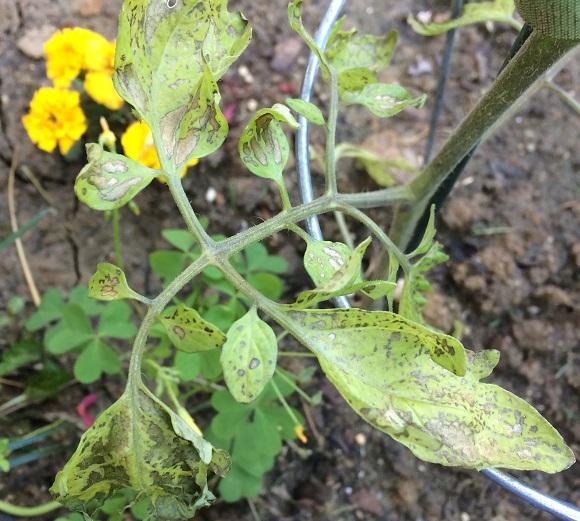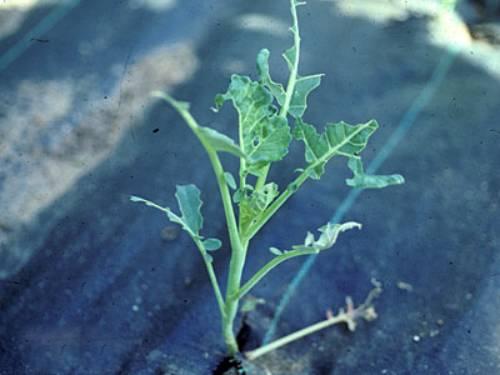Vegetable transplants and seedlings are young, tender plants and susceptible to damage when planted outdoors in the elements. Disease, environmental conditions, insects, and wildlife can damage plants.
Disease
Damping-off disease

- A number of soil-borne, fungal and bacterial root rots affect a wide range of vegetable crops.
- Three pathogens - Phytophthora, Pythium, and Rhizoctonia- are collectively referred to as "damping off". These pathogens are water molds - they must have free water to grow and reproduce.
- Damping-off can affect seeds in the ground prior to germination as well as young seedlings.
- Seedlings grown inside homes under fluorescent lights and in greenhouses succumb to damping-off if the media is poorly drained and kept too wet.
- In the garden, the disease can be a problem on poorly drained soils during cool, wet, and cloudy spring weather. Symptoms are more likely to be observed on slow-growing, weak plants. Above-ground symptoms include leaf yellowing and browning, stem cankers, and stunted and wilted plants.
- Rhizoctonia girdles or constricts lower stems (known as "wirestem") and pythium causes stunting, browning, and malformation of the root system. Damping-off is more likely to infect large seeds (corn, bean, pea).
Management of damping-off
TRANSPLANTS AND SEEDLINGS
Use soilless potting media for growing transplants. Don't overwater seedlings grown indoors or in a greenhouse or cold frame. Allow the top of the growing mix to dry slightly before watering. Plant seeds and transplants in loose, well-drained soil. Infected plants should be pulled up immediately, indoors or out in the garden, and composted.
IN THE GARDEN
Avoid planting seeds or transplants in low-lying, poorly drained areas. Plant on raised beds if your garden soil stays wet for days following rainfall. Plant at the proper depth and spacing. If you've had a problem with damping-off, mix in aged compost but avoid incorporating un-decomposed organic materials prior to planting (straw, leaves, fresh manure, etc.).
Seeds can also be pre-sprouted to give them a head start. Place seeds on a moistened paper towel. Roll up the paper towel, place it in a plastic bag with some holes and set it on top of the refrigerator. Check the germination rate after 5-7 days. When the radicle (new root) begins to develop, remove seeds and plant in garden soil. However, do not pre-soak bean and corn seeds in water. This treatment will make them more susceptible to soil pathogens.
Infected plants should be pulled up immediately, indoors or out in the garden, and composted.
Problems caused by nonliving factors (weather, drought, wind, etc)

This tends to happen if seedlings or transplants are planted too early. Unexpected late frosts and cold soil temperatures can injure or stunt young plants. Gardeners should be prepared to protect young plants from the elements as suggested in the bullet below. Check the last frost date in your area before planting.
- Drought, sustained winds, waterlogged soil, poor quality transplants, temperature extremes, and cloddy or compacted soils high in clay can all cause the stunting of young seedlings or transplants. Providing optimum conditions for good growth at this early stage will help ensure healthy growth and good yields through the season. Follow these cultural recommendations:
- Plant in well-drained soil high in organic matter.
- Use high-quality seed and transplants. Check transplants prior to purchase. Avoid plants with roots that are brown and growing around the bottom of the container.
- Keep soil evenly moist and fertilize with a balanced soluble fertilizer after seedlings emerge or after transplanting.
- Protect plants from wind and cold with floating row cover material, a cold frame, or cloche (e.g. an empty 1-gallon plastic milk jug with the bottom removed).
- Avoid damaging plant roots through cultivation, tilling, or walking on the soil.
- Plants grown under poor conditions will not produce adequate foliage or yields. In addition, low yields and poor eating quality can be expected if plant growth is checked significantly at any point in the life cycle - from seedling to fruit maturation.
Insects
Cutworms
- Older cutworm larvae feed near the soil surface, cutting off young plants at or below ground surface and sometimes pulling them underground to consume.
Earwigs
- Earwigs are a minor vegetable pest but sometimes will feed on young vegetable plants.
Seedcorn maggot
- Seedcorn maggots can be a reason why seeds do not germinate or when you dig up the seeds they are damaged or have a white maggot is inside.
Slugs/Snails
- Slugs feed on every part of host plants. They can consume entire small seedlings as well as tender stems, and chew ragged, small to large holes primarily in leaf interiors, instead of along the edge.
Southern corn rootworm
- The larvae of Southern corn rootworm tunnels into the roots and stems of corn, bean, and cucurbit seedlings causing damage.
Wireworms
- Wireworms are a common pest of shallots, onion, and garlic.
Wildlife

- Many wild and domesticated animals, including deer, voles, rabbits, birds, squirrels, groundhogs, rats, dogs, and cats may damage vegetable gardens occasionally or consistently. Be aware that wildlife tends to feed more heavily on vegetable crops during dry periods when little water is available.
- Deer, rabbits, birds, and groundhogs are the large animals most likely to feed on vegetable stems. Starlings, finches, crows, pigeons, and sparrows will dig out and consume seeds before or after they have germinated. Dogs and cats may also trample young seedlings.
- Animal tracks, droppings, the height of the cut-off stems, and type of chewing injury can provide clues that aid in the identification of the culprit(s). In un-fenced gardens, more than one type of animal may be feeding on plants. Deer may feed on almost any type of vegetable plant, depending on available foods, numbers of deer, time of the season, garden location, etc. Groundhogs are also fond of many different vegetable plants but seem to prefer members of the cabbage and cucumber families and sweet potato foliage (they generally do not eat eggplant or pepper foliage). Rabbits are more found of crucifers, leafy green vegetables, and beans. Deer lack upper incisors and leave a ragged edge to chewed stems. Rabbits and other rodents clip stems leaving a sharp, oblique edge. Rabbits cannot easily chew a plant stem that is more than 20 inches off the ground. Groundhogs and deer are more likely to feed in the early morning and evening. Be aware that wildlife tends to feed more heavily on vegetable crops during dry seasons when little water is available.
The following are some tips for minimizing wildlife problems
- A 3-foot high fence of chicken wire or other closely woven wire is very effective at excluding rabbits, groundhogs, cats, and dogs. Be sure that the fencing extends 4-6 inches below the soil line. Groundhogs are excellent diggers and can climb.
- A two-strand electric fence can be effective against a wide range of animals. The wires are strung 6-8 inches and 3 feet from the ground.
- Cover seedbeds and young plants with a floating row cover. This works very well for excluding all types of wildlife.
- Commercial repellents are available which work well against deer, rabbits, cats, and dogs. Small deodorant soap bars hung on stakes, cages, fences, and trellises can deter deer. Deer are more readily repelled by smell than by taste. Repellents lose their effectiveness over time and after rainfall. Dried blood or crushed hot pepper can also be sprinkled around the garden.
- Check with the Maryland Department of Natural Resources for information relating to wildlife problems and nuisance wildlife.
